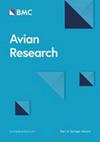Size of the ulna and taxonomic order affect vane dimensions of secondary remiges in birds
IF 1.7
2区 生物学
Q1 ORNITHOLOGY
引用次数: 0
Abstract
The number of secondary feathers varies among orders of birds with some orders exhibiting a positive relationship with ulna length, whereas in other orders secondary number is invariant. This difference has implications for scaling of the width of the feather vane within orders. In those species where the number of secondary remiges is invariant with ulna length, vane width should scale isometrically with ulna size to maintain an aerodynamic flight surface. Where feather count increases with increasing ulna length then vane width should exhibit negative allometry. Vane length should also correlate with ulna length, irrespective of the number of feathers. Data were compiled from an online library of images for the vane length and the width of the vane at 50% of the vane length for the fifth secondary feather for 209 bird species from 24 different orders. The results supported the hypotheses that vane width is a function of ulna size, and the number of secondary feathers as associated with different orders. Vane length was unaffected by the number of secondaries but varied between orders. The results suggest that birds have solved the problem of maintaining the aerodynamic surface of the proximal wing in two ways. Hence as ulna length increases the first solution involves more feathers that exhibit negative allometry for vane width, or in the second where feather count doesn't change, the vane width simply scales isometrically. The implications for the mechanical properties of the vane, and how it affects wing function, have not yet been explored in a range of birds.
尺骨的大小和分类顺序影响鸟类次生迁徙的叶片尺寸
次级羽毛的数量在不同目鸟类中有所不同,有些目与尺骨长度呈正相关,而另一些目的次级羽毛数量不变。这一差异影响了羽毛叶片宽度的尺度。在那些次级种群数量随尺骨长度不变的物种中,叶片宽度应与尺骨大小等距缩放,以保持空气动力学飞行表面。当羽数随尺骨长度的增加而增加时,叶片宽度应呈负异速生长。叶片长度也应与尺骨长度相关,而不考虑羽毛的数量。从一个在线图像库中收集了来自24个不同目的209种鸟类的叶片长度和第5次羽毛在叶片长度的50%处的叶片宽度的数据。结果支持叶片宽度是尺骨大小的函数的假设,以及与不同目相关的次级羽毛的数量。叶片长度不受次级数的影响,但在不同的顺序之间有所不同。结果表明,鸟类通过两种方式解决了保持近端机翼气动表面的问题。因此,随着尺骨长度的增加,第一种解决方案涉及更多的羽毛,这些羽毛对叶片宽度表现出负异速生长,或者在第二种解决方案中,羽毛数量没有变化,叶片宽度只是等距缩放。对于叶片的机械性能的影响,以及它如何影响翅膀的功能,还没有在一系列鸟类中进行探索。
本文章由计算机程序翻译,如有差异,请以英文原文为准。
求助全文
约1分钟内获得全文
求助全文
来源期刊

Avian Research
ORNITHOLOGY-
CiteScore
2.90
自引率
16.70%
发文量
456
审稿时长
46 days
期刊介绍:
Avian Research is an open access, peer-reviewed journal publishing high quality research and review articles on all aspects of ornithology from all over the world. It aims to report the latest and most significant progress in ornithology and to encourage exchange of ideas among international ornithologists. As an open access journal, Avian Research provides a unique opportunity to publish high quality contents that will be internationally accessible to any reader at no cost.
 求助内容:
求助内容: 应助结果提醒方式:
应助结果提醒方式:


